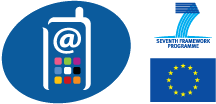





Mobile 2.0 Europe Developers Day — Barcelona, Spain, 18 June 2009
| François Daoust | Dominique Hazaël-Massieux | |
|---|---|---|
| fd@w3.org | dom@w3.org | |
 | @tidoust | @dontcallmedom |
This work is part of the MobiWeb 2.0 project supported by the European Union's 7th Research Framework Programme (FP7)
|
Relevant specifications:
window.applicationCache.update();
<input type="email" >
<input type="date" >
<input type="range" >sessionStorage.foo='bar';
localStorage.fooo='bar';Relevant specifications [continued]:
<widget xmlns='http://www.w3.org/ns/widgets'>
<name>Hello World</name>
</widget>Relevant specifications [continued]:
function showMap(position) {
// Show a map centered at (position.coords.latitude, position.coords.longitude).
}
// One-shot position request.
navigator.geolocation.getCurrentPosition(showMap);
